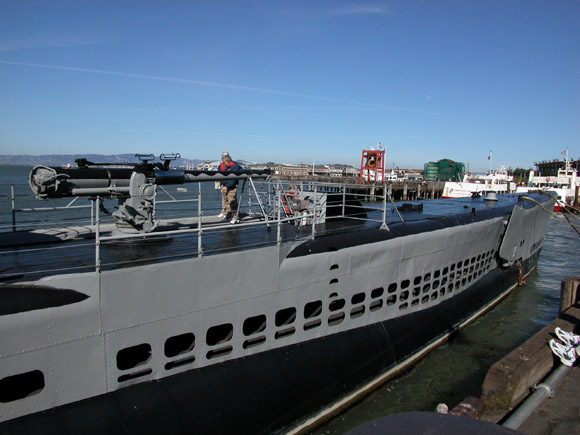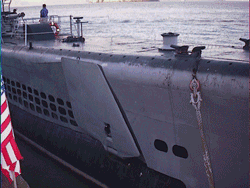|
Forward of the conning tower in this photo is a four-inch main deck gun. A small target, typically under 500
tons, would often be attacked with gunfire. Even in this case, the submarine
would maneuver underwater to make a surprise attack - called a "battle
surface". The technique was as follows: while still submerged, the gun crew would
assemble in the control room ready to start up the ladder. Maximum speed would be ordered and the surfacing
alarm would be sounded. The tanks would be blown but the diving officer
would try to hold the boat down with the dive planes while the tanks were being emptied. When he was unable to hold her down anymore
he would reverse his planes, the ship would pop to the surface and the
gun crews would run out, standing in water, spin the gun around to aim
at the enemy, open the breech, put the shell in and fire. All this could
be done in less than 40 seconds. Meanwhile, all topside shell lockers would
be opened to provide ready ammunition for the guns, more men would hasten
topside, ammunition would be passed from the magazine below the crew's
mess, and the battle would continue with a rapidly surfacing submarine.
Located on the forward gun deck of the conning tower in this photo is a single 20 millimeter
gun, and on the after gun deck a 40 millimeter gun. These guns were primarily
used as anti-aircraft weapons, and would also fire upon smaller surface targets. When a submarine is on the surface it is particularly
vulnerable to attack from aircraft and the normal defense was diving. By the end of WW II there were fewer large targets worth expensive torpedoes so they upgraded the guns. At the end of the war Pampanito had a 5" 25 cal gun on the aft main deck, 40mm guns forward and aft on the gun decks, and a twin 20mm gun forward on the main deck. Lookouts
were posted on the elevated platforms on either side of the periscope shears
to keep a watchful eye for potential danger. If an airplane was sighted
the order would be given to "clear the bridge," and they would dive instantly
and be fully underwater at periscope depth in about 30 seconds.

Other Features Forward on Deck
Bow Buoyancy Tank: The pointed bow of the submarine is formed
by the bow buoyancy tank. Water entered the tank through the arch shaped
holes at the waterline forward and was vented through flapper valves in
the forward deck. It provided a bubble forward for surface travel and an
up angle when blown during surfacing from a dive.
Bowplanes: These "wings" are located against either side of the bow. They are rigged (lowered) when diving and stored raised (upright) when traveling on the surface. The bow planes
primarily control the depth of the submarine; the stern plane, the angle on the boat.

Capstan and Anchor Windlass: The capstan is located on the forward
deck, the anchor windlass below the forward superstructure, and the anchor is
raised against the port bow.
(See the Bow Planes, Capstan and Anchor Windlass mechanisms below the main deck forward.)
Torpedo Tube Shutter Doors: Located in the bow at the waterline,
the large rectangular shutter doors can be seen. One door is above the
waterline, one can partially be seen and the third is located below the
water. There are 3 on each side of the submarine. The shutter door
is hinged to the outboard side of the muzzle door of the torpedo tube.
As the muzzle door was opened the shutter door slid forward and in toward
the centerline to allow the torpedo to exit the submarine.
Draft Marks: The numbers on the hull aft of the shutter doors
indicate the depth to the keel (each number is above 10, so that, for
example, Pampanito is drawing just under thirteen feet.)
Limber Holes: The arch-shaped holes cut into the side of the
superstructure above the shutter doors are the flood ports for the bow
buoyancy tank. This tank is vented through flapper valves located in the
deck above the tank.
|